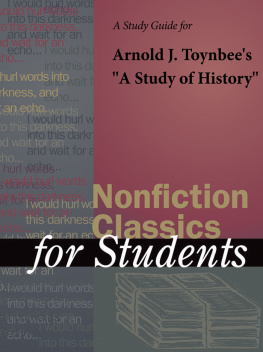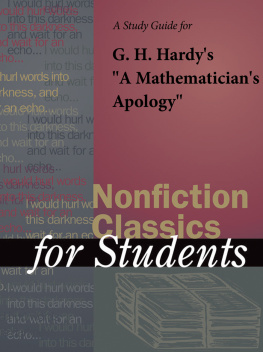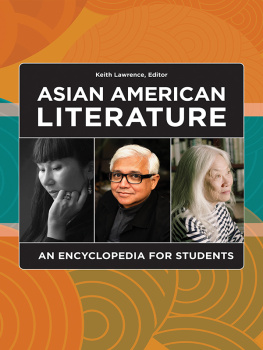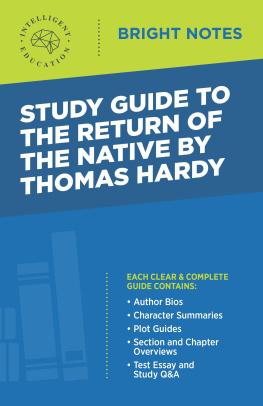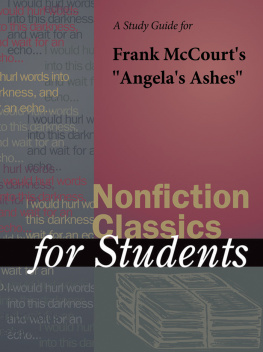TABLE OF CONTENTS
Guide
Nonfiction Classics for Students, Volume 1
Staff
Editor: Elizabeth Thomason.
Contributing Editors: Reginald Carlton, Anne Marie Hacht, Michael L. LaBlanc, Ira Mark Milne, Jennifer Smith.
Managing Editor, Literature Content: Dwayne D. Hayes.
Managing Editor, Literature Product: David Galens.
Publisher, Literature Product: Mark Scott.
Content Capture: Joyce Nakamura, Managing Editor. Sara Constantakis, Editor.
Research: Victoria B. Cariappa, Research Manager. Cheryl Warnock, Research Specialist. Tamara Nott, Tracie A. Richardson, Research Associates. Nicodemus Ford, Sarah Genik, Timothy Lehnerer, Ron Morelli, Research Assistants.
Permissions: Maria Franklin, Permissions Manager. Shalice Shah-Caldwell, Permissions Associate. Jacqueline Jones, Permissions Assistant.
Manufacturing: Mary Beth Trimper, Manager, Composition and Electronic Prepress. Evi Seoud, Assistant Manager, Composition Purchasing and Electronic Prepress. Stacy Melson, Buyer.
Imaging and Multimedia Content Team: Barbara Yarrow, Manager. Randy Bassett, Imaging Supervisor. Robert Duncan, Dan Newell, Imaging Specialists. Pamela A. Reed, Imaging Coordinator. Leitha Etheridge-Sims, Mary Grimes, David G. Oblender, Image Catalogers. Robyn V. Young, Project Manager. Dean Dauphinais, Senior Image Editor. Kelly A. Quin, Image Editor.
Product Design Team: Kenn Zorn, Product Design Manager. Pamela A. E. Galbreath, Senior Art Director. Michael Logusz, Graphic Artist.
Copyright Notice
Since this page cannot legibly accommodate all copyright notices, the acknowledgments constitute an extension of the copyright notice.
While every effort has been made to secure permission to reprint material and to ensure the reliability of the information presented in this publication, Gale neither guarantees the accuracy of the data contained herein nor assumes any responsibility for errors, omissions, or discrepancies. Gale accepts no payment for listing; and inclusion in the publication of any organization, agency, institution, publication, service, or individual does not imply endorsement of the editors or publisher. Errors brought to the attention of the publisher and verified to the satisfaction of the publisher will be corrected in future editions.
This publication is a creative work fully protected by all applicable copyright laws, as well as by misappropriation, trade secret, unfair competition, and other applicable laws. The authors and editors of this work have added value to the underlying factual material herein through one or more of the following: unique and original selection, coordination, expression, arrangement, and classification of the information. All rights to this publication will be vigorously defended.
Copyright 2001
The Gale Group
27500 Drake Road
Farmington Hills, MI 48331-3535
All rights reserved including the right of reproduction in whole or in part in any form.
ISBN 0-7876-5381-0
ISSN 1533-7561
Printed in the United States of America.
10 9 8 7 6 5 4 3 2 1
A Study of History
Arnold J. Toynbee
19341961
Introduction
Arnold Toynbee's multi-volume A Study of History is one of the major works of historical scholarship published in the twentieth century. The first volume was published in London in 1934, and subsequent volumes appeared periodically until the twelfth and final volume was published in London in 1961. A two-volume abridgement of volumes 1-10 was prepared by D. C. Somervell with Toynbee's cooperation and published in 1947 (volume one) and 1957 (volume two) in London.
A Study of History in its original form is a huge work. The first ten volumes contain over six thousand pages and more than three million words. Somervell's abridgement, containing only about one-sixth of the original, runs to over nine hundred pages. The size of the work is in proportion to the grandeur of Toynbee's purpose, which is to analyze the genesis, growth, and fall of every human civilization ever known. In Toynbee's analysis, this amounts to five living civilizations and sixteen extinct ones, as well as several that Toynbee defines as arrested civilizations.
Toynbee detects in the rise and fall of civilizations a recurring pattern, and it is the laws of history behind this pattern that he analyzes in A Study of History.
From the outset, A Study of History was a controversial work. It won wide readership amongst the general public, especially in the United States, and after World War II Toynbee was hailed as aprophet of his times. On the other hand, his work was viewed with skepticism by academic historians, many of whom argued that his methods were unscientific and his conclusions unreliable or simply untrue. Despite these criticisms, however, A Study of History endures as a provocative vision of where humanity has been, and why, and where it may be headed.
Author Biography
Arnold J. Toynbee was born in London on April 14, 1889, the son of Harry V. Toynbee, a social worker, and Sarah Edith Marshall Toynbee, a historian. Showing academic promise at a young age, Toynbee won scholarships to attend Winchester School from 1902 to 1907, and then Balliol College, Oxford, where he studied Classics and graduated in 1911. In the same year, Toynbee pursued his interest in ancient Greek history by studying at the British Archeological School in Athens. In 1912, he became a fellow and tutor at Balliol College, a position he held for three years. Unable to perform military service because of his health, during World War I he worked in the Political Intelligence Department of the War Office and was a member of the British delegation at the Paris Peace Conference in 1919. He also held the Koraes Chair of Byzantine and Modern Greek Studies at London University in 1919.
In 1925, Toynbee began a thirty-year tenure as director of studies at the Royal Institute of International Affairs and professor of international history at London University. He was a prolific author, writing more than 140 articles and books between 1921 and 1934, including The Western Question in Greece and Turkey (1922), Greek Historical Thought (1924), Greek Civilisation and Character (1924), the annual Survey of International Affairs (1923-1927), and A Journey to China (1931). He was also at work on A Study of History, for which he is best known. The first three volumes of this investigation into the rise and fall of civilizations were published in 1934; volumes 4-6 followed in 1939.
From 1943 until 1946, Toynbee directed the Research Department at the Foreign Office. He also attended the second Paris Peace Conference as a British delegate. In 1954, volumes 7-10 of A Study of History were published. An abridged version, prepared by D. C. Somervell with Toynbee's cooperation, appeared in two volumes (1947 and 1957).
Toynbee's massive work made him one of the best-known historians of his time although it also proved controversial. The final, twelfth volume,

